Fear of exposure to the novel coronavirus, and the business closings and stay-home orders imposed by state and local governments (and suggested by the federal government), have led to a significant decrease in U.S. automobile traffic since March 1. No one is quite sure how much vehicle miles-traveled (VMT) has decreased – all we have so far are estimates based on anonymized cell phone data from places like Streetlight Data (map here) and INRIX, and some anecdotal information from some toll bridge and turnpike collections. But a drop of at least 40 percent in non-truck VMT would not be surprising, and it could be worse than that.
If only there was some precedent into what happens when government forces a drastic reduction in VMT. Oh, wait, there is…
The World War II experience in gasoline rationing may provide some interesting parallels.
Background. It is important to remember that WWII gas rationing was never really about saving gasoline. The U.S. had plenty of oil production and refinery capacity as of 1941 to meet all war needs (in those days, the U.S. was a significant oil exporter, and those exports to places like Japan stopped as the war began).
However, then as now, North America lacked a single, solitary rubber tree. And, even though the rubber tree was native to South America’s Amazon basin, a fungal blight that started in 1910 had killed almost all the rubber trees on all the plantations in the Western Hemisphere by 1940, leaving the only significant rubber supplies in Southeast Asia – which were no longer accessible after December 7, 1941.
The problem wasn’t really that rubber was essential for making car and truck tires – cars and trucks had existed before pneumatic rubber tires were invented, running (uncomfortably and inefficiently) on steel rims. The problem was that natural rubber was (and is to this day) the only way to make high-pressure airplane tires, and rubber was also indispensable then for making the gaskets, hoses, and belts that made engines of all types run.
The Office of Production Management banned the manufacture of most new tires for civilian use five days after Pearl Harbor (see p. 6406 here), and President Roosevelt formally ordered a tire rationing system on December 27, 1941 (see p. 72 here).
After exhortations to the public starting in mid-1941 to conserve gas were mostly unsuccessful (Roosevelt even asked the state governors in March 1942 to impose 40 mile per hour speed limits to save rubber), FDR ordered gasoline rationing in the 17 Eastern Seaboard states on May 12, 1942 (see pp. 3482 here). This was related to a temporary supply shortage – Roosevelt had donated many of the U.S. oil tanker ships to Great Britain, reducing the ability to get processed petroleum products from Gulf Coast refineries to the East Coast and causing some shortages. (This was before pipelines.)
FDR appointed a blue-ribbon panel headed by Bernard Baruch to analyze the whole rubber situation. That panel’s report was blunt:
Gas rationing is the only way of saving rubber. Every way of avoiding this method was explored, but it was found to be inescapable. This must be kept in mind: The limitation on the use of gasoline is not due to shortage of that commodity – it is wholly a measure of rubber saving. That is why the restriction is to be nationwide. Any localized measure would be unfair and futile.
Accordingly, President Roosevelt ordered the gas rationing program extended to the whole country on November 6, 1942 (see p. 9135 here) with the effective date later postponed to December 1, 1942 (see p. 9787 here).
The goal of rationing was explained: “Wear and destruction of tires now in use must be reduced by curtailing the national average automobile mileage to a maximum of 5,000 miles per year.”
The rationing was actually done by miles and then translated into gallons: “a passenger automobile is conclusively presumed to operate 15 miles, and a motorcycle 40 miles, per gallon of gasoline.” The basic ration was 16 gallons per month, for an assumed total of 2,880 miles per year. Workers in war-related industries got twice the basic ration, medical personnel and postmen and clergy got even more, and first responders and some VIPs got unlimited mileage. (There was a separate rationing system for truckers.)
Gas rationing’s effects on traffic. The old Traffic Volume Trends reports on the FHWA website actually go as far back as April 1942. The system of data recorders estimating vehicle miles-traveled was still being installed on a nationwide basis, but where recorders existed, in the month before East Coast rationing took effect, VMT was already down by 14.8 percent in April 1942 versus April 1941.
But once gas rationing in the East started in mid-May, the results were obvious.
|
1st Half of May 1942 (vs 1941) |
2nd Half of May 1942 (vs 1941) |
| Non-rationed States |
-13.6% |
-16.9% |
| Rationed States |
-18.0% |
-45.0% |
| U.S. Total |
-15.9% |
-31.5% |
Subsequent annualized data in Table VM-201 shows that passenger car VMT in 1942 was 21 percent lower than 1941, and passenger car VMT dropped another 26 percent in 1943 – a 43 percent reduction from the 1941 peak. VMT was basically flat in 1944 and then started to pick up in 1945 as the war wound down. Truck traffic also dropped, but not so sharply – a 15 percent drop in 1942 followed by another 9 percent drop in 1943.
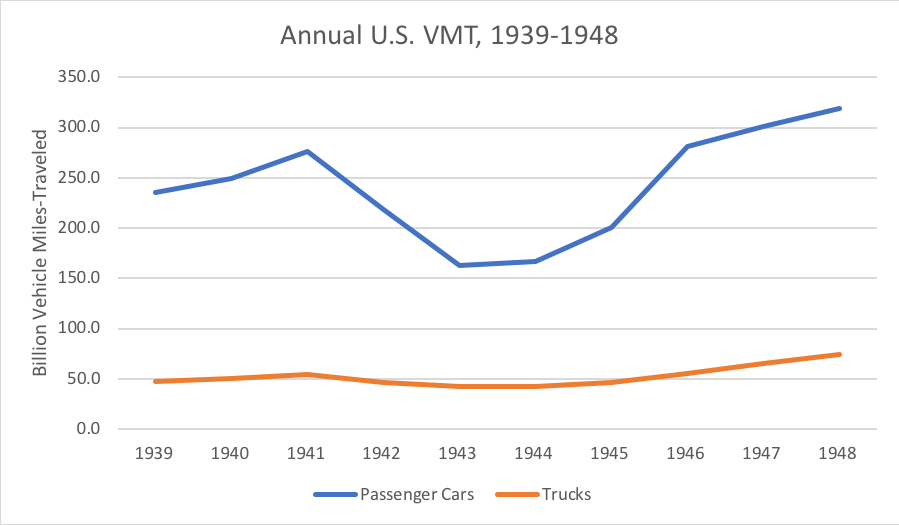
As a result of the rationing, the highway use of gasoline dropped by 18 percent (4.2 billion fewer gallons) in 1942, and dropped another 20 percent (3.8 billion fewer gallons) in 1943, before stabilizing.
Indexed at 1939 levels, car and truck VMT and highway use of gasoline looked like this:
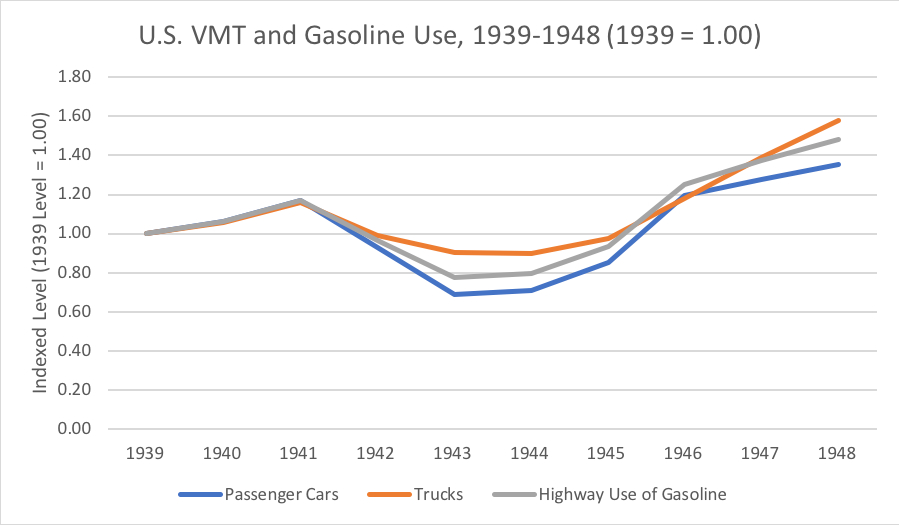
Effects on state highway programs. A federal plan to decrease the use of gasoline naturally affected state gasoline tax receipts, which were (and are) the revenue mainstay for state highway programs. States didn’t really increase gas taxes during this period – per Table G-205, the average state tax rate was 3.96 cents per gallon in 1940 and had only risen to 4.10 cents per gallon by 1945. By 1943, total state motor fuel tax receipts were 29.5 percent below their 1941 levels.
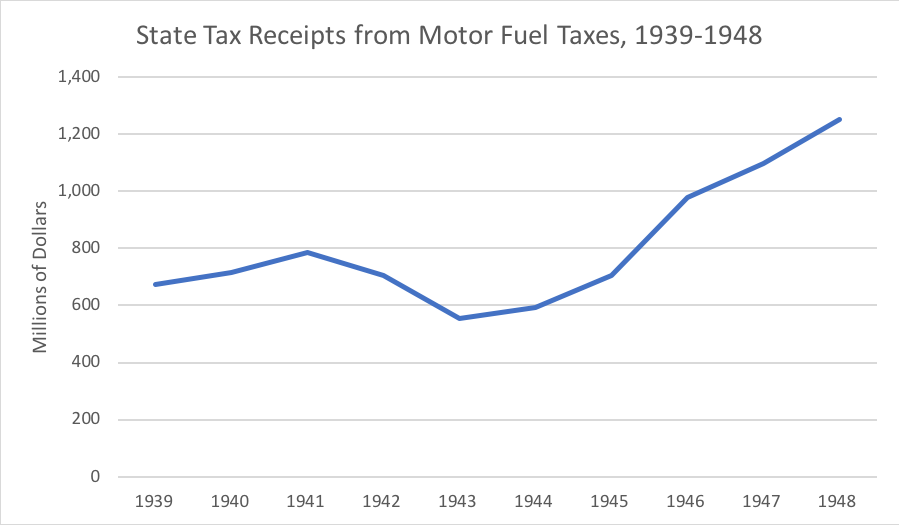
At the same time, the federal government walked away from the traditional federal-aid highway program for the duration of the war, letting the old apportionments spend down without providing any new apportionments. (Some of this was unrelated to the war – New Deal direct aid had to some extent supplanted the old federal-aid matching program by the late 1930s.) Federal outlays spent by states as matching funds dropped from $172 million in 1939 down to just $58 million by 1945 before rebounding in the post-war highway program.
In addition, the federal government wound up eating up most of the market for all new bonds in the U.S. during the war, restricting the ability of states and cities to sell their own debt. Buying federal war bonds was patriotic duty; buying state or local debt was not. (State highway financing via bond issuance dropped from $205 million in 1941 to $33 million in 1942 and stayed low through the end of the war.)
As a result of all of these factors, total state spending on roads was $1.06 billion in 1944, $566 million less than in 1941 – a 35 percent spending reduction over three years.
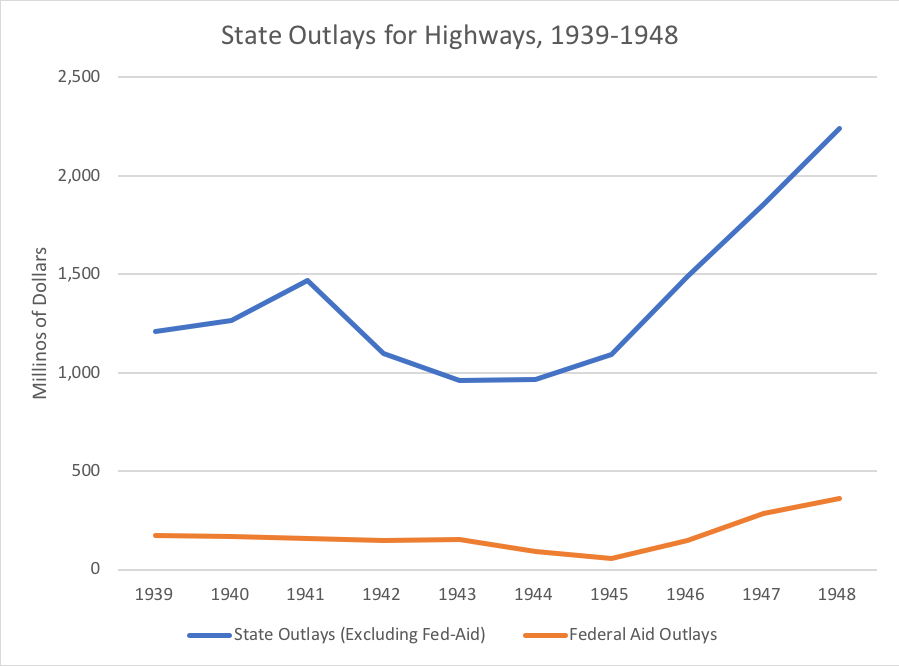
Safety effects. The drop in VMT, the removal of most single males ages 18-35 from the pool of domestic drivers, and the nationwide 35 mile an hour speed limit (called “Victory Speed“) imposed by the Office of Defense Transportation in September 1942 (see p. 7694 here), all had a marked effect on traffic safety during World War II. Per Table R-200, highway fatalities dropped from just over 38,000 in 1941 to around 23,000 per year in 1943 and 1944.
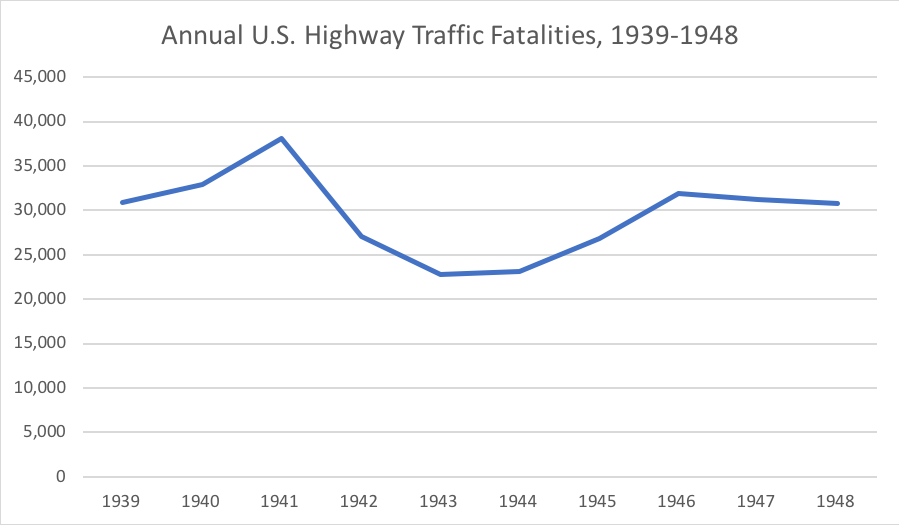
Gas rationing and the federal speed limit ended when Japan surrendered, and the soldiers who returned home really wanted to drive. There was a corresponding increase in highway fatalities in the last half of 1945. This caused President Truman, in December 1945, to announce “The loss of life, the bodily injuries, and the destruction of property resulting from these accidents are a drain upon the nation’s resources which we cannot possibly allow to continue.”
Truman therefore called the first presidential highway safety conference, which drew some 2,000 state and local highway officials and safety advocates to DAR Constitution Hall in May 1946. (See Richard Weingroff’s typically thorough write-up of the conference and its two successor conferences here). Or, better yet, see the write-up in the inaugural January 1947 issue of the Eno Foundation’s Traffic Quarterly.








